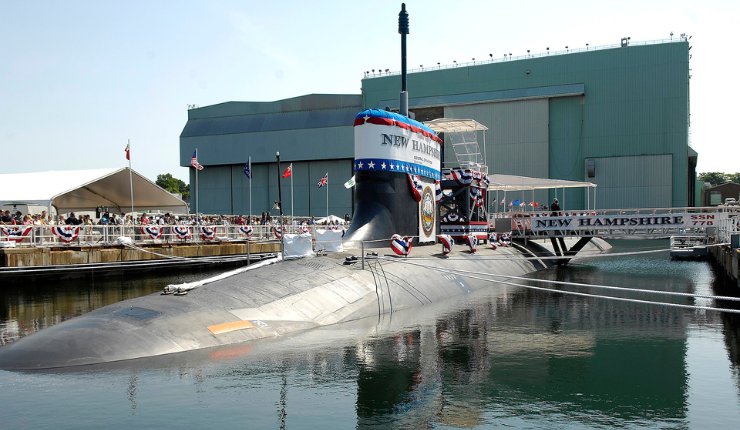
Shipbuilders 3D-Printed a Part for a Nuclear Submarine
The Navy is looking into having printers on submarine, ready to print spare parts while at sea. The goal is to reduce repair times and increase ship availability.
Newport News Shipbuilding’s VP of engineering and design Dave Bolcar says the effort leverages authorizations that streamline requirements for low-risk additive manufacturing metal parts. The resulting parts must meet strict Navy standards, but are expected to reduce lead times for critical components.
The part is a deck drain
A crewed submarine is, at its most elemental level, a machine designed to preserve a bubble of air underwater and keep the rest of the ocean out. Every aspect of its design, from propulsion to sensors and controls, must be crafted with this overriding goal in mind. That means even seemingly insignificant components, such as a deck drain, can play an important role in ensuring the submarine stays safe and functional.
The Navy hopes to speed up production and delivery of submarines by introducing the technology of additive manufacturing, or 3D printing. The process allows manufacturers to make parts on demand, which could cut costs and lead times for critical parts. This would be especially useful for components that are frequently in short supply at public shipyards, according to a Navy program office official.
Additive manufacturing could also reduce the need to store spare parts aboard ships, which can waste valuable space in a tight and crowded environment. Instead, a fleet of onboard printers could provide replacements while a submarine is at sea, or printers on the dockside can quickly provide replacements for a ship that has returned to port.
General Dynamics Electric Boat and Huntington Ingalls Industries’ Newport News Shipbuilding division have made a significant step toward on-demand submarine repair with the successful 3D-printing of a copper-nickel deck drain assembly. The part, which is currently undergoing final machining and assembly, will be installed on the Virginia-class submarine USS Oklahoma (SSN 802).
The 3D-printed deck drain is just one small piece in a larger effort to integrate additive manufacturing into the construction of nuclear-powered submarines. The technology is already used for some non-critical parts, including the hull, but the Navy is aiming to use it for more critical parts, such as deck drains and steam lines.
The navy is currently pairing suppliers that cannot meet demand for critical parts with additive manufacturing companies that can print them on demand, a service program office official told Defense News. The program aims to speed up production and delivery of submarines and cut the cost of maintenance. The Navy hopes that the technology will be widely adopted by its suppliers, which can then pass the savings to customers.
The part was 3D-printed by Huntington Ingalls Industries
The US Navy has taken a step forward in its adoption of 3D printing technology by installing the first metal part made with this technology on an in-service warship. The Newport News Shipbuilding division of Huntington Ingalls Industries produced the part, which will be used in a steam system on the aircraft carrier USS Harry S. Truman, and will be monitored and evaluated over the course of a year. The part is a prototype of a piping assembly and will serve as an example for how 3D printing can be used in the production of metal parts for military ships.
The project was a collaborative effort between Huntington Ingalls Industries-Newport News Shipbuilding (HII-NNS) and GE’s advanced manufacturing business. The companies worked together to design and model the part, which was then 3D printed by NNS using a ProX DMP 320 metal 3D printer from 3D Systems. NNS then sent the part to AMMCON for final machining and assembly. The resulting part is made of copper-nickel and will be installed on the Virginia-class submarine Oklahoma (SSN 802).
NAVSEA’s approval of this new technique opens up many possibilities for the use of 3D printed metal parts in Navy ships. It also speeds up the time it takes to get a new component from an order to completion, compared with traditional casting and forging processes.
In addition to accelerating delivery times, the Navy hopes that it will also cut costs by utilizing additive manufacturing to produce parts. This approach will allow the Navy to produce its own 3D-printed components without having to rely on external suppliers, which can be costly.
According to HII officials, there were a lot of hurdles that had to be overcome before the NAVSEA could approve a part made with this technology for use on a naval vessel. For one, the Navy has very strict requirements for the materials that can be used in its parts, said a company spokesman, Justin Rettaliata.
The first 3D-printed part to be approved for use on a military ship was a drain strainer orifice designed to remove water from the steam line when it’s in operation. It was manufactured by NNS, and was printed with a special material called a 316L stainless steel. Stainless steel is a highly corrosion-resistant material that can be used in many applications.
The part was 3D-printed by GE
The Navy’s far-reaching fleet requires the latest technology to support its missions. Whether patrolling the oceans or conducting a raid on a terrorist base, sailors depend on high-tech equipment that needs to be replaced quickly and reliably. Having parts shipped to a Navy ship as quickly as possible allows crew members to get back on the job sooner and minimizes downtime.
This is why the Navy has taken an interest in 3D printing, also known as additive manufacturing, which allows parts to be made layer by layer. The process is expected to speed up production and delivery of submarines to the Navy by reducing lead times. It is especially useful for highly specialized parts, such as those found on nuclear power plants.
GE, which supplies much of the equipment on the Navy’s ships, has already begun working with additive manufacturing. The company is partnering with the Department of Energy (DOE) to conduct tests that will help it develop a process to print replacement parts for nuclear power plants. Its first effort will be to produce a sample of the part and then ship it to Idaho National Laboratory for irradiation and inspection. The test will help GE Hitachi Nuclear Energy (GEH) determine if the material can be engineered to resist corrosion and stress cracking after irradiation.
In another test, GE used its Arcam printer to print a copper-nickel deck drain assembly for a Virginia-class submarine. The result was a part that was lighter and stronger than traditional castings. In addition, the part could be printed in multiple pieces and then assembled. The part was then finished by machining and painting. The resulting assembly was a success and a step toward integrating additive manufacturing into the shipbuilding process.
Using 3D printing for the navy’s fleet will require changes in how the Navy certifies materials and the parts that go on its ships. However, it is a promising technique and will help the Navy reduce maintenance costs and shorten its supply chains.
Capt. John Markowicz, the in-service carrier program manager, told USNI News that he believes it is possible to cut the time required to get spare parts from the supplier to the ship with the use of additive manufacturing. In addition, he said that it could also free up space on the ship for more important equipment.
The part was 3D-printed by AMMCON
The US Navy stretches around the world as one of the farthest-reaching branches of the North American superpower. The Navy’s demanding mission requires the very best in technology, including cutting-edge 3D printing. HII’s Newport News Shipbuilding division and General Dynamics Electric Boat have advanced efforts to integrate additive manufacturing, or 3D printing, into construction of the Navy’s Virginia-class nuclear submarines. The companies believe that the use of certified 3D-printed parts can accelerate production and delivery of submarines to the Navy by cutting lead times for critical components.
The Navy’s reliance on printed parts hasn’t been without its challenges. It takes a lot of time and energy to make sure that the parts are safe and certified for use in the harsh conditions of a navy submarine. To do this, the Navy has worked with manufacturers to streamline requirements for low-risk additive manufactured parts. This effort has accelerated the pace of new part approvals and cut the lead time for critical components.
A duct that serves as a deck drain on the submarine is an example of how the Navy is using this technology to reduce the amount of work required in the shipyard and at sea. The drain is made of copper-nickel, a material that can withstand the high temperatures and pressures found in submarines. Earlier this year, Newport News Shipbuilding and GDEB, in collaboration with manufacturing supplier AMMCON, 3D-printed the part and then machined it for final machining and assembly before installation on the USS Oklahoma (SSN 802).
This collaborative challenge leverages authorizations made by the Navy that streamline necessities for low-risk additive manufacturing elements. It’s attainable as a result of foresight and longer-term improvement efforts by our engineers to deploy additive manufacturing marine alloys for shipbuilding, said Dave Bolcar, the vice president of engineering and design at the Newport News Shipyard, the Huntington Ingalls Industries division that labored on the 3D-printed half.
The deck drain is expected to be installed on the submarine this calendar year. GDEB and Newport News Shipbuilding are also working with AMMCON on the development of other parts that could be printed and used in the submarine’s systems. This could include a pipe fitting, which would help connect other pieces of the submarine.







